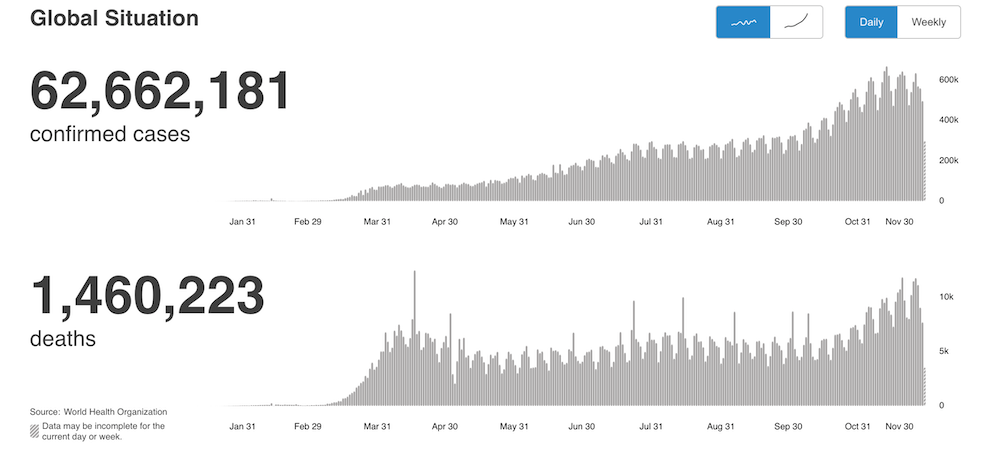2020 is shaping up to be a missing year for most of us. This is thanks to none other than the culprit of COVID-19, a silent killer that has ravaged countries around the world. Inconspicuously spread from victim to victim, the virus does not discriminate, and it spares no one, no matter young or old.
To say that we’re past the peak of the pandemic is an understatement. Indeed, cases in some countries have reached an uneasy stalemate; for others, the number of confirmed cases climb alarmingly high, day after day.
An entire year has passed since the virus first surfaced; perhaps it’s time to step back, evaluate the situation, and recall how the timeline of how events played out:
1 December 2019: First reported case
Hubei Province was first hit by a savage outbreak of influenza, which impacted Yichang, Xianning, and Wuhan the most. Local health officials were criticised to their slowness in dealing with the virus, resulting in slow diagnoses and flawed testing. This, naturally, has been rebutted by the Chinese government, and while CNN has reached out for an official response, they have not yet received an official answer.
1 December 2019 also marks the date when the first known patient showed symptoms of the coronavirus in Wuhan.
10 February 2020: Mismatch in reporting of new cases

Interestingly, Hubei officials reported just over 3,900 new cases, with China reporting 2,478 new cases nationwide. However, documents show that internal circulation within Hubei reported a larger number of 5,918 cases. Who’s right or wrong? We’ll let you make the call.
Discrepancies in reporting metrics might have resulted in the differing numbers, with China coming up with a new system by mid-February. Top health and provincial officials were also removed from their positions by that time. Testing was also ramped up, which definitely helped the situation!
1 March 2020: China sounds the alarm

Many of you might have heard of Li Wenliang, a doctor in Wuhan who was formally reprimanded for trying to alert the authorities of the severity of an ongoing ‘SARS-like virus’. Unfortunately, he passed away on 7 February 2020 after contracting COVID-19. His death was not a lone case – by 10 February 2020, six healthcare workers had also succumbed to the virus. This information was regarded as highly sensitive, as it shed unwanted light on the overworked situations of frontline staff.
On 14 February 2020, the first death caused by the virus was reported in Europe. And finally, on 1 March 2020 – an entire three months after the first reported case in Wuhan, might we add – China sounded the alarm and alerted the U.S. of the pandemic.
7 March 2020: Underreporting of daily new cases and total deaths
2,986 deaths were reported for the Hubei province; however, internal documents show that the real figure was actually 3,456. Percentage wise, the reported number of deaths seemed to be only 86 per cent of what possibly occurred.
Possible reasons boil down to inaccurate testing, as well as long waiting times. The high false-negative rate was of particular concern. Additionally, in the initial parts of the outbreak, the average time needed to process a case was 23.3 days. To put that in perspective, that’s just about a week shy of an entire month!
However, by March, the processes took a turn for the better, with 80 per cent of new confirmed cases recorded on the same day that they were diagnosed.
1 December 2020: One year after the first reported case

Fast forward to 1 December 2020, exactly a year after the first case was reported in Wuhan. Till now, the origins of the virus still remain unconfirmed. Speculations place the virus to stem from a market in Wuhan. However, there is a lack of conclusive evidence to officially prove this.
In a nutshell, as of 1 December 2020, there have been 62,662,181 confirmed cases worldwide. There have also been a staggering 1,460,223 deaths across the world! Data shows an exponential increase in the number of confirmed cases since the start of the pandemic, with the number of deaths fluctuating through the months.
For a further breakdown of confirmed cases, there are over 26 million in the Americas, over 18 million in Europe, over 10 million in Southeast Asia, over 4 million in the Eastern Mediterranean, over 1.5 million in Africa, and over 800,000 in the Western Pacific. The U.S. alone has more than 13 million confirmed cases, with India and Brazil following behind with over 9 and 6 million confirmed cases respectively.
For something a little closer to home, Singapore has had over 58,000 confirmed cases, with 29 deaths. While Singapore recently faced a hopeful two-week period of zero community cases, it looks like a second wave is imminent, after a community case was found to have mingled with 12 people at a restaurant in Seoul Garden.
However, until a suitable vaccine is found, tested, and mass-distributed, it might be a long time before we’re completely out of the woods.
Here’s to hoping that things gradually start returning to normalcy. Until then, be socially responsible, and stay safe. Together, we can – and we will – fight this!
Note: Information in this article has been extracted and adapted from an article published on CNN.
Join the conversations on THG’s Facebook and Instagram, and get the latest updates via Telegram.














